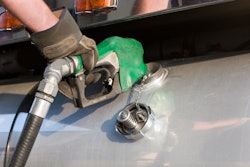The cost of trucking in 2021 increased to its highest level in the 15-year history of the American Transportation Research Institute’s annual Operational Costs of Trucking research – almost $1.86 per mile.
Though fuel saw the single largest jump in expense (a 35.4% increase to 41.7 cents per mile), nearly every other line-item cost center also grew or remained constant. Even when fuel costs are removed, the marginal costs of trucking increased by 10 cents between 2020 and 2021, from $1.338 to $1.438.
Joining Jason and Matt this week on CCJ's 10-44 is ATRI’s Alex Leslie, who goes into more details about how trucking’s costs changed last year.
CCJ's 10-44 is a weekly video feature covering the latest in trucking news and trends, equipment and technology. Subscribe to our YouTube channel here.
[Related: Recent shift in market conditions changing the driver pay conversation]
Contents of this video
00:00 How did trucking’s operational costs change from 2020 to 2021?
00:55 ATRI’s annual Operational Costs of Trucking survey
02:27 Other truck related costs
03:57 Tires
06:44 Decrease in liability insurance
09:27 Driver wages and benefits
10:51 Fleet size versus operational costs
Advertisement:
This week's 10-44 is brought to you by Chevron Delo 600 ADF ultra low ash diesel engine oil. It's time to kick some ash.
Matt Cole:
How did trucking's operational costs change from 2020 to 2021? A new ATRI report dives into the numbers.
Jason Cannon:
Hey everybody. And welcome back to the 10-44, a weekly webisode from the editors here at CCJ. I'm Jason Cannon and my co-host on the other side is Matt Cole. While not quite as drastic as the first half of this year, costs for everyone are still on the rise throughout the year and trucking companies are definitely feeling the squeeze.
Matt Cole:
In the American Transportation Research Institute's annual Operational Costs of Trucking survey, ATRI found that carriers costs were the highest in 2021, in the 15 year history of the report. We are joined again by ATRI research analyst, Alex Leslie, who talks about the findings of the annual survey and the areas that cost carriers the most compared to previous years.
Alex Leslie:
We saw the highest cost on record this year. It hit $1.85 per mile, which is an increase of about 12.7% from last year, which is a pretty significant jump. But when I say this year and last year, 2021 data is the basis of this 2022 report.
Alex Leslie:
2021's data, the costs were relatively low that year due to a number of factors and mostly fuel costs being so low. In 2020, there was actually a slight decrease in the cost per mile from 2019. But then we saw that swing way back in 2021, for that again, 12.7% increase. And that's true at the per mile level. Also the per hour level, we saw that cost go to $74.65 cents.
Alex Leslie:
The cost centers that we saw the largest increases in were fuel, of course, no surprise there. Fuel was up little over 35%. We all know that it continued to really jump up over the first half of 2022 as well. But even excluding fuel, we saw marginal costs were going up by 7.5%. So even if we take out those fuel costs, the increase was still about 10 cents per mile. And of those remaining cost centers, of course, repair and maintenance was a really big one, 18.2%. And then driver wages were 10.8% increase.
Jason Cannon:
As Alex noted, fuel costs were up about 35% in 2021. And that's not even counting what happened this year, beginning in February. Apart from fuel though, other truck related costs were also higher in 2021 than they were in 2020.
Alex Leslie:
One thing that we've seen is this was a really challenging market for trucks and also for parts, right? We had a shortage of new trucks, difficulty keeping up to demand there. In addition, then that bled over into the used market. We're all familiar with how this happened.
Alex Leslie:
And then repair and maintenance. We had the combination then of parts shortages, but then also the fact that a number of fleets were looking at either they couldn't get the trucks that they'd initially intended to purchase, or the prices were so high that they decided instead of purchasing or leasing trucks, we're going to try to run the ones that we have longer, we're going to try to put more into repair and maintenance.
Alex Leslie:
So what we saw is... We had two approaches, really one was the costs went up big on the truck purchase side of things and the other was that repair and maintenance costs really jumped. So carriers tended to lean in one of those two directions as they tried to manage that, again, really challenging environment. But regardless of which way they leaned, repair and maintenance really jumped up. That was despite the fact that tire costs remained relatively stable from 2020 to 2021.
Matt Cole:
One area of vehicle related costs in which carriers reported lower prices than the year before was a little bit of a surprise: tires. Alex says there are a couple explanations for that though.
Alex Leslie:
Our sense is a couple of things. First all is that tire costs were already very high in 2020. And so part of it is it's a slight decrease this year, but it's still one of the highest tire costs that we've seen. Part of it is just that relative fact that it was already high to begin with.
Alex Leslie:
We think part of it too, is that we knew that tire costs were going to increase. That was a pretty straightforward increase. And we knew pretty much the rates that they were going to increase, the sticker price that was going to increase. So I think a lot of carriers were able to kind of get out in front of that. Some of them were putting in orders ahead of time, stocking up if they could even. So I think some smart purchasing on the part of carriers helped them avoid some of those increases.
Alex Leslie:
And then again, even though prices went up on tires, some of the fears that we had... Is there going to be a wheel shortage? Is there going to be a rubber shortage? Some of that didn't end up materializing, at least to the degree that we'd feared at the start of the pandemic. So that all helped, I think, shield carriers a bit from the costs of tires going up, even though that sticker price was adjusted up over the course of the year.
Jason Cannon:
Probably the most surprising area that carriers reported decrease in cost was liability insurance, even though it was a small per mile decrease. Alex explains what might be behind that trend after a word from 10-44 sponsor Chevron lubricants.
Advertisement:
Protecting your diesel engine and its after treatment system has traditionally been a double edged sword. The same engine oil that is so essential to protecting your engine's internal parts is also responsible for 90% of the ash that is clogging up your DPF and upping your fuel and maintenance costs. Outdated industry thinking still sees a trade off between engine and emission system protection and Chevron was tired of it. So they spent a decade of R and D developing a no compromise formulation. Chevron lubricants developed a new ultra low ash diesel engine oil that is specifically designed to combat DPF ash clogging.
Advertisement:
Delo 600 with Omnimax technology cuts sulfate Ash by whopping 60%, which reduces the rate of DPF clogging and extends DPF service life by two and a half times. And just think what you can do with all the MPGs you're going to add from cutting your number of regens. But Delo 600 ADF isn't just about after treatment. It provides complete protection extending drain intervals by preventing oil breakdown. Before you had to choose between protecting your engine or your after treatment system, and now you don't. 600 ADF from DEO with Omnimax technology. It's time to kick some ash.
Alex Leslie:
his one requires a bit of unpacking because it's very interesting. First of all, the difference was a one-tenth of as cent decline, so essentially no decline, right? Essentially it remains stable and remaining stable is remaining at the highest level we've seen it. So that's the first thing to note about this finding.
Alex Leslie:
The second thing is that insurance costs... Well, let me just say that carriers who participate in our data collection usually trend towards the slightly safer end of things. And that's good, right? You don't want to benchmark yourself against carriers that are really sort of scraping the barrel. But as a result, our insurance costs don't reflect the sort of full swing that you'd see if you were taking every single carrier. That said, another factor to consider here is that the insurance industry actually saw... For the first time in a decade, they saw profits in their underwriting, in the commercial auto insurance sector. For the last 10 years, they've seen underwriting losses in commercial auto and that has been one of the major drivers of the increase in premiums.
Alex Leslie:
So for this year, there was finally some adjustment shaking out. Those increases in premiums finally translated over to insurers, getting out of the red in this sector. And that, I think, is the good news in terms of what this is going to look like hopefully for next year as well. Hopefully on the insurer side of things, this means that there's been a bit of correction and we'll have a little bit more stable rate of increase, rather than some of these jumps that we've seen.
Alex Leslie:
There's one more factor. Insurance is such a complex... We could talk all day about just insurance, but the other factor involved is that, actually, we always encourage carriers to look at premiums alongside their out of pocket incident costs, because that's really a better metric for how much you're paying for your risk. And what we saw this year was that every year large carriers tend to pay more out of pocket than small carriers. They pay less for their premiums than small carriers.
Alex Leslie:
But this year we saw those out of pocket costs going up a bit actually, and that actually ended up offsetting the advantage for large carriers. So I think a lot of carriers right now are trying to look around and see, what do we need our policy levels to be? Where can we get savings on premiums that will maybe translate over to more upfront costs on our part, but lower costs overall? And this year it looked like some of the larger carriers maybe were still trying to figure out what the optimal level was.
Matt Cole:
One area that's not surprising that carriers saw fairly significant increased costs was in driver wages and benefits.
Alex Leslie:
So we saw both of those going up. The driver wage increase was 10.8%, which is big, but we haven't seen the ceiling yet on that. Despite the fact that, again, it's jumped up a couple years in a row now by large percentages. The thing to keep in mind is that in 2021, we had consumer inflation of 7%. So if we're talking about just the sort of real wage increase, it's down to something more like 3.8%.
Alex Leslie:
And then on top of that, of course, there were wage increases in every industry. The federal statistics over at the BLS, I want to say had it at maybe 4.5% across the board. That's the really environment that you have to be thinking of. We can't just look at that driver wage increase by itself. It's great to see it go up that much, but these things are always relative, especially in a competitive labor market like this one. And so I would expect probably to see that same rate of increase over this year and maybe even next year too, just because, again, it's that rising tide lifts all boats, kind of factor here, between inflation and industry as a whole.
Jason Cannon:
ATRI also found that smaller carriers generally had higher operating cost and larger fleets based on a number of factors.
Alex Leslie:Smaller carriers, they have a trickier time with... They're not able to negotiate rates as well for things like fuel. They're not able to hit some of the efficiencies in areas like repair and maintenance, for example. Where large carriers, they've got their own shops, they're able to manage some of those costs. They're able to buy parts at a larger scale. Tires, for example, is one of the areas where we see a classic economy of scale curve, where the larger you get, the more units you have, the lower that per mile marginal cost is.
Alex Leslie:
But it is offset by a few factors. Smaller carriers tend to pay less in driver benefits and that's one area where they end up saving a bit. But we did see some interesting curves. The small versus large carriers when it came to wages. In the truckload sector, for example, for the second year in a row, we saw smaller carriers were actually paying a little bit more in wages than large carriers, and that's offset in part by benefits. But it is an interesting trend that we've seen. Small carriers have been at the forefront as well of driver wage increases. So they're finding ways to be competitive in that wage market. That means that those margins are tough for small carriers because they're managing those costs.
Alex Leslie:
But overall this year we found that small carriers were able to cut that difference in costs, compared to large carriers, only about 4.90 cents, so about 5 cents, which really reduced that difference from 2020 in particular, where pandemic made a lot of costs unpredictable.
Jason Cannon:
That's it for this week's 10-44. You can read more on CCJDigital.com and as always, you can find the 10-44 each week on CCJ’s YouTube channel. And if you've got questions, comments, criticisms, or feedback, please hit us up at [email protected], or give us a call at 404-491-1380. Until next week, everybody stay safe.










